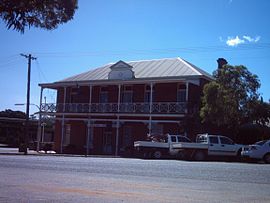Ravensthorpe, Western Australia
|
Ravensthorpe Western Australia |
|||||||
|---|---|---|---|---|---|---|---|

Ravensthorpe Community Centre, formerly the Freemasons Hotel, built 1906
|
|||||||
| Coordinates | 33°34′54″S 120°2′49″E / 33.58167°S 120.04694°ECoordinates: 33°34′54″S 120°2′49″E / 33.58167°S 120.04694°E | ||||||
| Population | 438 (2006 census) | ||||||
| Postcode(s) | 6346 | ||||||
| Elevation | 232 m (761 ft) | ||||||
| Location | |||||||
| LGA(s) | Shire of Ravensthorpe | ||||||
| State electorate(s) | Eyre | ||||||
| Federal Division(s) | O'Connor | ||||||
|
|||||||
Ravensthorpe is a town 541 km south-east of Perth, 40 km inland from the south coast of Western Australia. It is the seat of government of the Shire of Ravensthorpe. At the 2006 census, Ravensthorpe had a population of 438.
In 1848, the area was surveyed by Surveyor General John Septimus Roe who named many of the geographical features nearby, including the nearby Ravensthorpe Range that the later town was named after. There was also one of the Western Australian Government Railways isolated branch lines between Hopetoun and Ravensthorpe, the line opened in 1909.
Alluvial gold was discovered at the Phillips River in 1892. At the goldfield a de facto town emerged, known as Phillips River. The government completed construction of a copper and gold smelter about 2 km south east of the town in 1906, used to cast copper and gold ingots.
A temporary pastoral lease ("Free Run") was registered by James Dunn senior in 1868. His five sons and daughter started sheep farming at the property, Cocanarup (20 km west of the present town), in 1871, after George and John Dunn drove a herd from Albany. In 1873 the family was granted a permanent lease of 4,049 hectares (10,010 acres).
By 1901, the population had climbed to over 1,000 and the government gazetted the town, renaming it Ravensthorpe. The area continued to prosper and the population grew accordingly, by 1909 the population was over 3000. The prosperity was short-lived; World War I took its toll on the town and by 1918 the local copper smelter had closed and many of the copper and gold mines had closed. The population of the town in 1968 was approximately 800 people.
After the war Ravensthorpe survived servicing the farming in the district. Agriculture in the area began to grow following the great depression and pastoral land releases occurred in the 1960s and 1970s. The surrounding areas produce wheat and other cereal crops. The town is a receival site for Cooperative Bulk Handling. A bulk wheat bin was constructed in the town in 1947 capable of holding over 30,000 bushels.
...
Wikipedia

